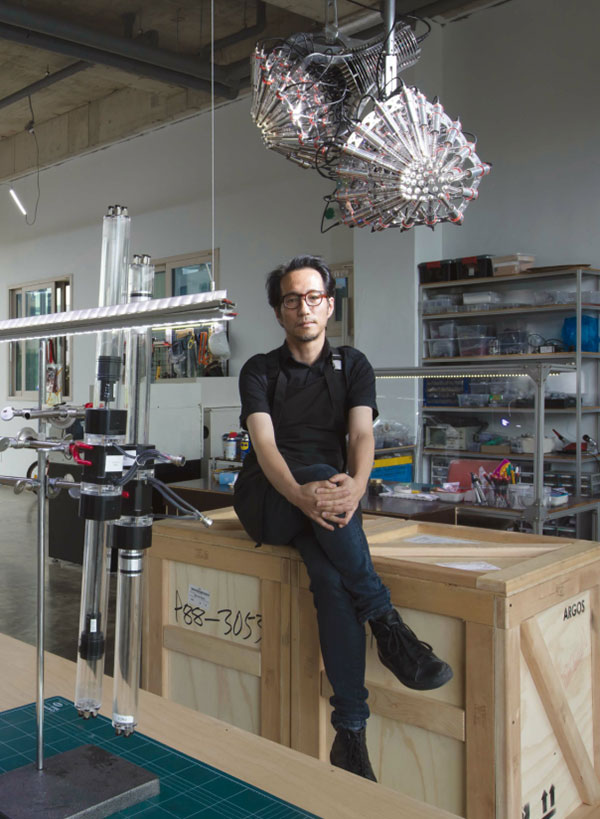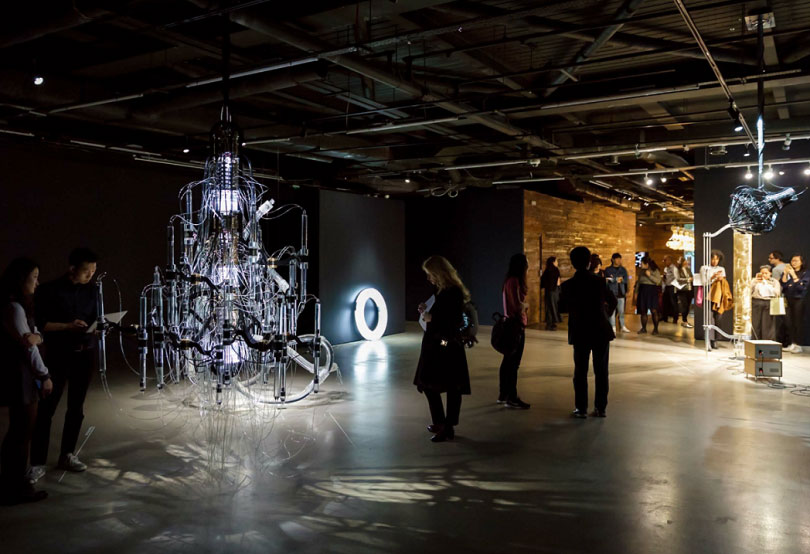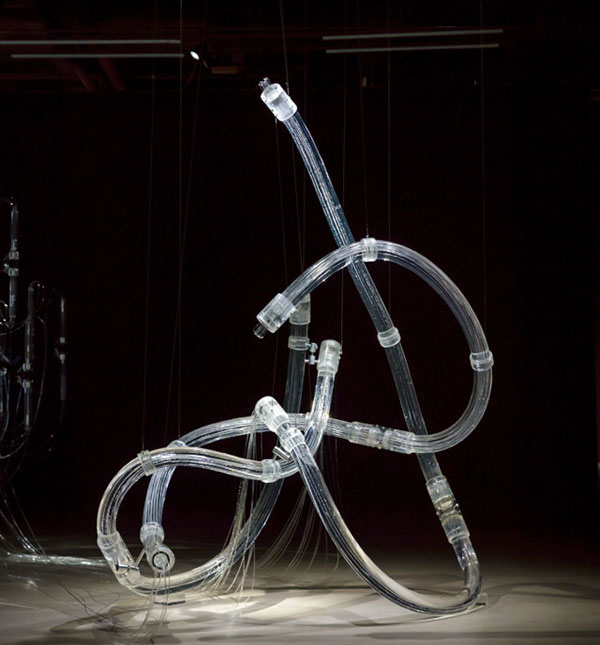
Visualizing imperceptible matter and photonic flow, Yunchul Kim’s works make the viewers imagine the vast field of energy operating them. Needless to say, the energy is something undetectable by human senses, therefore difficult to recognize as a subject of materiality, but it’s precisely this energy that Kim seeks to materialize into a perceptible reality. His works have adhered to the extended contexts of this idea. Readers can experience for themselves this recognition of unrecognizable energy at Kim’s solo exhibition 《Glare》 (Barakat Contemporary, September 19 - November 17, 2019).

Artist Yunchul Kim. Photoⓒ Hong-soon Park
Yunchul Kim (b. 1970) studied musical composition at Chugye University for the Arts and audiovisual media at Kunsthochschule für Medien Köln. He’s held 15 solo exhibitions worldwide, including in Korea, Germany, Slovenia, and Great Britain, and has also partaken in numerous group exhibitions and special exhibitions around the globe. He has won the Collide International Award 2016and honorable mentions at the Ars Electronica (2006) and the Transmediale (2004). Kim currently works in Incheon, Korea.
I felt a strange sense of anachronism at the wild enthusiasm for the recently released film. It was a sense of irony deriving from the fact that iconography, a branch of art history that has become an outdated way in visual arts critique, still holds a firm stance in popular film critique. The fact that the key to proving the excellence of a film—a genre in the forefront of contemporary visual culture—is not to look at the degree of execution or the texture of the visual but the number of hidden symbols and their decipherability tells us that people see images as vessels carrying meaning instead of independent objects with materiality and form.
What Kim problematizes is not so far-removed from this idea, though he looks not to images that have managed to escape the system of the language but to the material, the basic source of the image. This takes the focus off of the semantic and visual representation of a subject and onto the physical makeup of the representation. In other words, when looking at a painting of an apple, Kim focuses not on the apple (indicative meaning) or the representational form (image) but on the paint (the material base of the representation) itself. What makes Kim’s works unique is his practice of art as a way of establishing a new philosophical perception on art, and moreover, the world—much more microscopic and macroscopic than that pursued by materialistic abstractionists like Clement Greenberg. According to the artist, the materiality he pursues is “the state before linguistic definition, the state before formation, the dimension before culturalization.” This fundamentally overthrows the Western philosophy that has established hierarchies by separating and distinguishing material from concept, and the entire premise of Western art that has interpreted the image as a representation.

A view of Yunchul Kim’s solo exhibition 《Dawns, Mine, Crystal》 held at the Korean Cultural Centre UK in 2018. ⓒDan Weill, Mark Blower, and Yunchul Kim.
To Kim, matter is something unseparated from the world. It’s not something permanently fixed in one state, and neither is it the opposite of ritual or concept. To establish this theory, he introduces the concepts of “mattereality” and “mattering,” translatable to “the reality of matter’s existence” and “the becoming of matter” respectively. These concepts assume matter to be imperfect and under perpetual change and see reality and phenomenon as inseparable. Mattereality, by Kim’s definition, is a phenomenon in which matter “is not a partial constituent of the world surrounding it,” but one in which it “endlessly fluctuates, intertwines, implicates itself, and ‘becomes’ all the while unseparated from reality.” In fact, mattereality is not a hypothesis but a physical truth that we all experience: chemical reactions that seem complete are actually in a metastable state of dynamic equilibrium and may resume with a change in conditions; all objects including our bodies are also in perpetual interaction with their environments, constantly affected by the entropic force. Matter is not something distinguishable from the world or its beholder; it’s a system of cosmic continuity that continuously interacts with and interpenetrates the world and its beholder. This perspective shares many commonalities with various Western philosophies that reject human-centered and dichotomous metaphysics epitomized by Bruno Latour’s actor-network theory, Quentin Meillassoux’s speculative realism, and Gilbert Simondon’s concept of active matter. What Kim emphasizes above all is the concept of “process” and “non-human agency,” which directly links to his work process during which countless experiments are administered in his studio to materialize the properties in his imagination. Kim agrees with Alfred North Whitehead’s idea that reality consists of processes and not material objects, and that processes are best defined by their relations with other processes and therefore reality cannot be constructed by independent bits of matter. He also identifies with Karen Barad’s philosophy that not only the subjects for measurement but also the measuring devices and the observing behavior are active agents. This is why all of Kim’s works are in perpetual motion, reacting to their environments and nearby subjects, and often organic in physical form. Not only the final artworks themselves but also the experimental process of finding the right material, the mechanics of the detection devices, the space in which the work is placed, and the audience’s reaction to the work all become a part of the work as participating agents. The most effective way to turn the conceptually and linguistically represented world into a perpetually fluctuating world of matter is to come face to face with the literal materiality that has yet to be defined by language. 〈Effulge〉 (2014), one of Kim’s well-known works first shown at the National Museum of Modern and Contemporary Art, Korea, explores the material properties of a metallic liquid by creating a fluidic flow reminiscent of the convection of plasma around the primitive universe or the sun. The flow of the unidentifiable particles doesn’t represent reality but presents matterreality, which is to say that it offers a physical and phenomenological encounter before any semantic process kicks in. In his microtube installation 〈Cascade〉 (2016–2017), the tubes are bent at an equal refraction index as the microfluid so that the tubes are invisible when the fluid runs through them but becomes visible either when the fluid is absent or when the hydrogel is formed, literally visualizing fluid motion. In his recent work 〈Amorph〉 (2018), a hydrogel is applied with force to generate internal stress, which changes the form, hence the refraction index, of the material, creating ornate and colorful light deflections. In this case as well, what we come to see is neither the phenomenon nor the concept, but the pure (free of artificial dye), the inherent color of the gelatinous material.

Yunchul Kim, 〈Tubular〉, 2018. PDMS (polydimethylsiloxane), microtube, dimensions variable.
Something to remember at this point is that Kim’s intention is not to simply offer an experience of the physical properties of new material. Although it’s true he wants the materials to “display events unique to them under certain circumstances” and therefore conception of new materials with certain dispositions and the experience of their unique properties hold an important status in his works, his goal is not to invent materials with certain dispositions but to induce a state of intra-action in which matter constantly interacts with the world. This essentially makes his works practices of “mattering” that combine material with a concept and not inventions of matter as in a form of reality. In that sense, 〈Flare〉 (2014), in which fluids of two different gravities and polarities twirl up and down without mixing, doesn’t merely demonstrate organic fluid motion and its formative beauty, but also realizes the poetic imagination of the compatible coexistence of materials as rendered in poet Novalis’ claim “Water is a dampened flame.” The glimmer of light refractions created by stacking thin, stretched layers of the hydrogel in his new work 〈Coptic Light〉 (2019) is also not just an experiment in terms of the material or the abstract color aesthetics, but a manifestation of Gaston Bachelard’s idea of the “laminated reality.”
With that said, an exhibition space, where works composed of diverse materials congregate and visitors observe them, would be precisely where the multilayered “network of mattereality” unfolds, and the exhibition at Barakat Contemporary is a good opportunity to confirm that. The interconnection between the exhibition space and the outer universe is substantialized through an artwork reactive to muon particles flown in from space—the interaction of pumps and tubes that mimic the osmotic structure of a tree generates constant flow of fluids; the force applied to the hydrogel is visualized through changes in the refraction index and the color of the material. The works each reveal their own “material dispositions as a perpetually changing subject,” but what’s more important is the energy created by the collision of the disparate works in the space and the changes in our reaction. The reason we go to exhibitions is for the stimulation the works offer, and Kim’s exhibition allows for the audience and the works to exchange energy on the most primal level. Beyond a phenomenological encounter, observing how coincidence, intent, science, and aesthetics are interwoven to visualize energy would be an interesting intellectual encounter.

Yunchul Kim, 〈Effluge〉, 2012–2014. Acryl, glass, aluminum, photonic crystal, neodymium, magnet, motor, microcontroller, electromagnetic field generator, air pump, 410×160cm (dimensions variable).
※ This content was first published in the September, 2019 release of Wolganmisool Magazine and has been re-published on TheARTRO.kr after a negotiation was reached between Korea Arts Management Service and Wolganmisool Magazine.
1 Yunchul Kim, “Mattereality,” System and Art, Ehaksa, 2017, p. 209.
2 Henri Bergson, translated by Jongwon Park, 『Matter and Memory』, Acanet, 2005, p. 451.
3 Yunchul Kim, ”Mattereality,” p. 198-205.
4 Yunchul Kim, “Yunchul Kim: Seeking for the Potential Imbued in Matter” (discussion between Yunchul Kim and Hee-young Kim), [Space], February 2015, p. 99.
5 Yunchul Kim, “Poetically Imagined Fluid,” [Art in Culture], October 2017, p. 77.
Hye Jin Mun / Art Theory
Hye Jin Mun is a critic, translator and lecturer at Korea National University of Arts. Her major interest is technology-based media and cross-media study in contemporary art.


